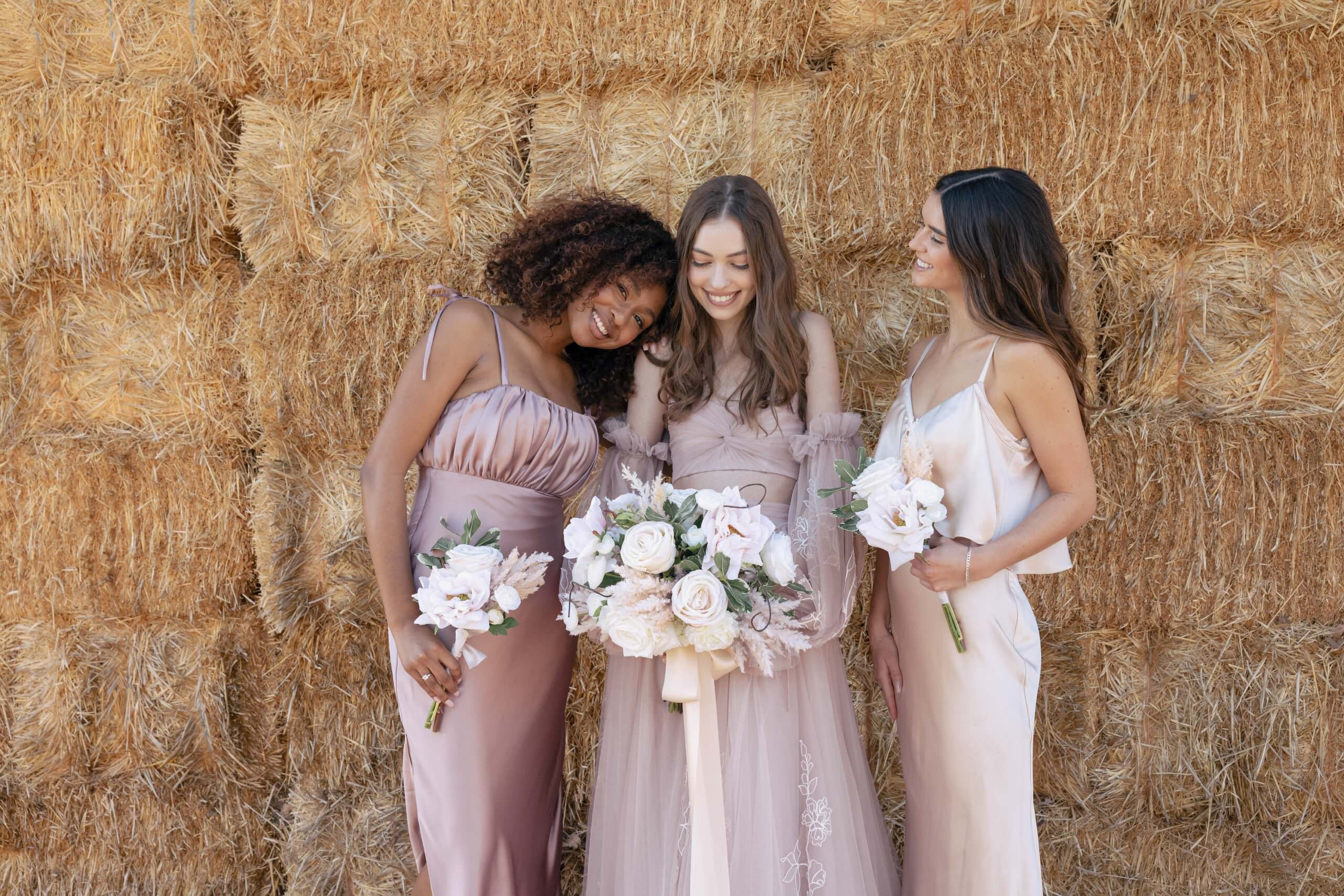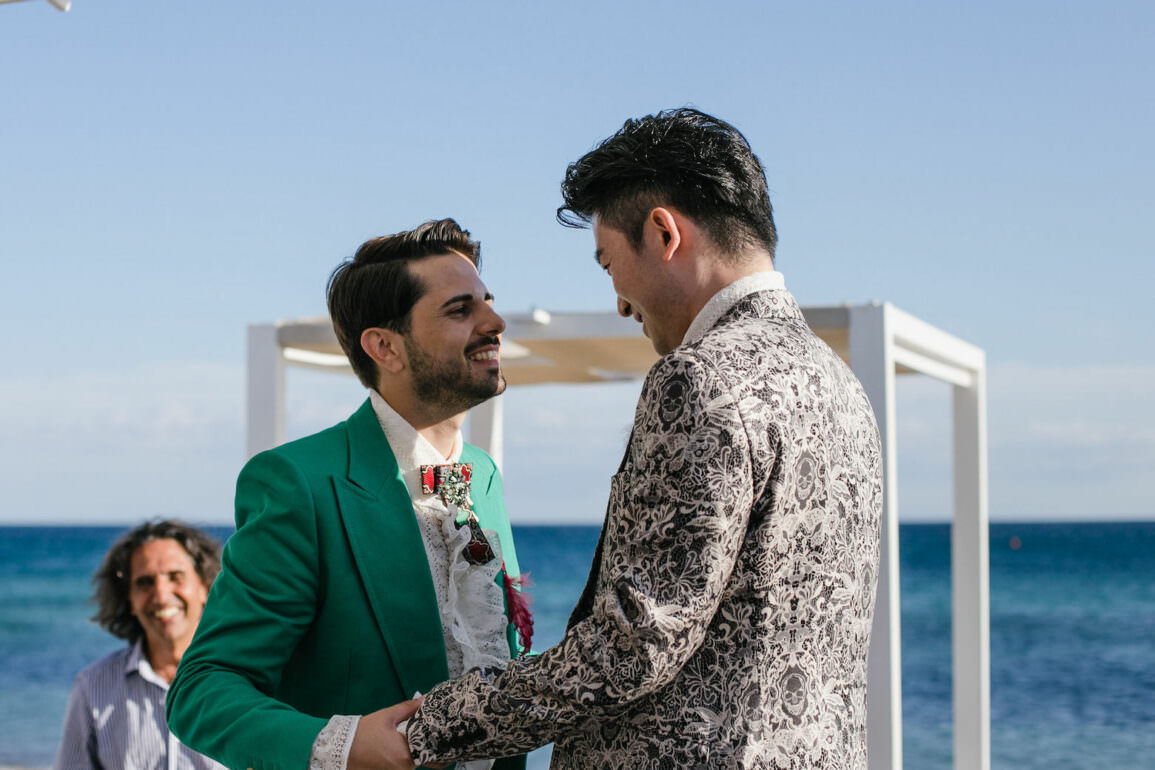Faux flowers are having a real moment.
On the laundry list of vendors you’ll be looking to hire for your upcoming wedding, a florist is likely to find its way to the very top. But if you’re someone with a close eye on budget, as well as your impact on the environment, you might be questioning your floral design choices. The seasonal cycles of your local blooms, and how they're grown and harvested, play a huge role in costs and eco-friendliness.
The cost to purchase fresh flowers for your wedding will run about $2,000 to $4,000 on average, and research has found that an estimated 45 percent of cut flowers wind up dying well before they are even purchased by a consumer. These florals are also often sprayed with chemical fertilizers, pesticides and dyes that can cause negative impacts to the environment.

For these reasons and more, artificial flowers, or synthetic imitation flowers made up of reusable materials, are becoming increasingly popular. Manufactured in a factory or, in some cases, handmade, using materials such as cloth, paper, plastic and even silk, artificial flowers come with the benefit of not using up water, requiring relatively little maintenance and sometimes lasting for years. In fact, at Something Borrowed Blooms, a company that produces silk wedding florals, their products are reused upwards of 26 times per year before being recycled, according to Lauren Bercier, co-founder and CEO.
Because they are synthetic and manufactured or handmade, the vibrancy and luster of artificial flowers also tend to last much longer, thanks to added UV-protection, and do not require hydration, which can be beneficial for keeping wedding-day blooms perky in warmer climates.

The History of Artificial Flowers
While they sound like a new invention to curb climate change, artificial flowers are anything but; they’ve actually been around for thousands of years. “The Chinese began using silk to craft artificial flowers about 1,500 years ago and the trend then spread to Europe and eventually America, but didn’t become popular in the States until the late 19th-century Victorian Era,” explains Bercier. “By the 1920s, even florist shops were substituting live florals with silk flowers in order to make up for seasonal shortages.”
Artificial flowers have come a long way since the 1920s, now being manufactured using materials that are so lifelike, few can differentiate them from real blooms.
The Key to Sustainability
If your goal with going faux is to reduce your carbon footprint, you may have to actually up your floral budget. The majority of artificial blooms are, for the most part, plastic. While there are options with more natural materials, they can get pricey.
The only way that the more budget-friendly options can truly be better for the environment is if they’re used multiple times, such as with Something Borrowed Blooms. “If faux flowers are single-use, they also pose significant planetary threats aligned with those of plastic pollution and general landfill waste,” notes Natasha Berg, Director and Board Member of Oceanic Global.
Additionally, when it comes to increasing carbon footprint, the main culprit isn’t fresh flowers in general, but rather purchasing fresh flowers that are not local or in season, adds Lara Mahler, founder and chief planner of The Privilege Is Mine in New York. Thus, the way to reduce the carbon footprint is to buy fresh flowers locally, which means couples need to be flexible with their flower varieties.
TIP: Your floral designer may be able to mix-and-match real with artificial! Have an out-of-season bloom that you love? Look into adding silk versions of it to your arrangements.
Types of Artificial Flowers
Artificial flowers can be made out of many different materials, and it's important to know which type you are purchasing. Here is a look at the most popular types and what experts think is worth your time and budget.
Silk Flowers
Silk flowers are the most popular type of artificial flower. Not only do they look realistic, but they also come in a wide variety of colors and styles. The downside to silk flowers, however, is that they can be pricey and their durability isn't as strong as other alternatives.
If you go the silk-flower route, it’s important to make sure that the flowers are, in fact, made from real silk, as many varieties are now made from silk-alternatives such as polyester or nylon.
Foam Flowers
Foam flowers may look realistic, but they feel like foam when you touch them. “These florals are very lightweight and can be used in a variety of arrangements, but each flower looks the same so arrangements will look less realistic,” says Bercier. You can purchase foam flowers in bulk on several vendors, including Amazon, but might be sacrificing quality.
Wax-Coated Flowers
Despite what you might assume, wax-coated flowers are often even more expensive than silk flowers; however, they are also even more realistic. These artificial blooms are coated with a waxy covering that gives them a very natural look. You get a very high level of detail on these flowers, including veining and unique markings in addition to shine.

Paper Flowers
Paper flowers are a good choice if you want something that is eco-friendly and unique, keeping in mind that it is a more delicate option, and can be time-consuming if you decide to make them yourself.
Wood Chip (Sola) Flowers
Wood-chip flowers are made from the wood pulp of the tapioca plant, so are eco-friendly and biodegradable. While they may not be as realistic as other options, wood-chip flowers have their own unique aesthetic.
What to Look for Before Purchasing Artificial Flowers
Quality
Quality is the single-most important factor to consider when buying artificial flowers. “Most of the time, silk flowers on an end cap in your local chain store are not very durable or high-quality, and may lose pigment over time if exposed to the sunlight for an extended period of time,” explains Danielle Browning, owner and lead designer of Dashing Designs LLC in Ohio. She recommends looking for silk blooms that are mechanically constructed, durable, and hold up well, including the petals.

Materials
Take a close look at the petals and leaves of any artificial flower brand you are considering to determine whether they’re made from real or plastic fabric. There’s a big difference. “If they're made from plastic, they're more likely to fade in sunlight and be less durable than those made from fabric,” warns Diane Kolanović-Šolaja, creative director and owner of Dee Kay Events in New Jersey. She also recommends checking to see whether or not the flowers are wired. “Wired flowers will last longer and be easier to arrange than those without wires,” she adds. Finally, check to make sure the stems are strong and sturdy. Thin, flimsy stems will break easily and be more difficult to work with.
Budget
Cost savings is one of the biggest benefits when it comes to choosing silk over fresh. According to Bercier, the average couple sets aside about 10 percent of their wedding budget for florals. Considering that the average couple spends about $3,000 on fresh wedding flowers, they can stand to save a great deal by going artificial. For example, an average wedding order with Something Borrowed Blooms is just $500. “If you’re stretching your budget too thin with fresh florals, the result could be a disappointment,” says Bercier. “If you find yourself in that situation, consider a silk alternative to maximize your budget without sacrificing style.”

Style
In Kolanović-Šolaja’s experience, tropical faux flowers, such as monstera, ginger and anthurium, are the easiest to work with since the varieties in nature can easily mirror artificial ones. “Most tropical arrangements will have a few of these stems to highlight the design, so you don't have to purchase many,” she says. Her all-time favorite is a real-touch artificial orchid, which she says is wildly similar to the fresh variety.
Browning believes that delicate fresh flowers, like scabiosa and baby's breath, work well as artificial substitutes, especially in the summer, as hotter temperatures can affect certain fresh flowers on outside installs. “For example, fresh hydrangea would not live for very long outside in the sun, even with a water source; however, artificial hydrangea would still produce the same lush look as fresh, but would hold up in the sun forever,” she says.
Bottom Line
As with any major purchase for your wedding, there are a few pros and cons to consider before going the artificial-flower route. The benefits are that they are long-lasting, they don’t cause allergies in those prone to seasonal rhinitis, they are relatively low-maintenance, and they can be reused. Kolanović-Šolaja also points out that artificial flowers come in a wide variety of colors and styles to suit any wedding style and design. “The colors alone can make any dream flower design a reality,” she says. “Nature might not deliver a monochromatic bright blue and purple wedding in dahlias and peonies colors, but artificial ones can make this happen.”
The cons are that artificial flowers can sometimes look fake and unnatural and may not be as sustainable as their reputation leads them to be.
No matter your choice, always opt to work with a trusted vendor who has good reviews, as this will help ensure the most positive experience.
Written by Jenn Sinrich | Originally featured in Love Inc. V8













You must be logged in to post a comment.